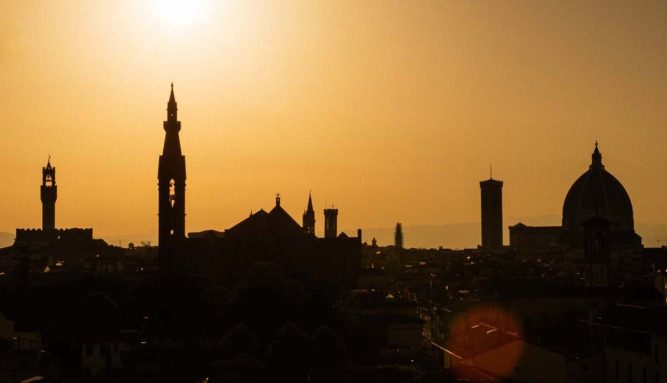Touring Florence Towers & Fortresses

Florence has long been heralded as a city so rich in cultural value that it can be likened to a living, breathing museum. It’s newest project affirms this assertion — the city’s historical defense system, consisting of towers, gates, and fortresses, is now open for tours and visits.
The network of structures was born a very long time ago, around 1284, under the instruction of the Signoria di Firenze, the council that called the shots in Florence at the time. Over the centuries, subsequent rulers gradually expanded the network of defense as they saw fit.
Tommaso Sacchi, the City Councillor of Culture, believes that the initiative intends to be a means for people to have a both comprehensive and accessible look at the city’s heritage. The towers and fortresses selected for the project can all be toured and climbed — the collection is a truly tangible museum of history and architecture.
After a very successful opening to the public of the Torre San Niccolò in 2011, this idea of an ensemble of monuments was born, with the original Torre of course included. The public is in for an extra treat now that the Rampe del Poggi fountain, located just beside the Torre, has just been restored and reopened. The view from the top of the Torre offers an exclusive birds-eye view of the fountain, in addition to the ever-present sight of the city’s sprawling red roofs and green cypresses.
Not far from the Torre San Niccolò lies the Forte Belvedere. Originally constructed as a means of defense, it has since had a history of celebrity appearances, so to speak: the clout-thirsty Medici family used the fortress as a symbol of their status; astronomer Galileo Galilei used it to spearhead groundbreaking research; and Kim Kardashian, iconic social media trendsetter, chose the site as the perfect spot for her 2014 destination wedding to musician Kanye West. Now — lucky for us — it is open to common members of the public. Not only are there tours of the fortress, but another, surprising little gem sweetens the deal: Visitors will have the opportunity to get a first look at a room called “la stanza del tesoro,” an underground space carved into the hillside that stored the Medici family treasure. The Forte will also be the site of a variety of other events this summer, outside the scope of this particular project.
Torre della Zecca, located almost directly across the river from Torre San Niccolò, is more than meets the eye. Thanks to the fact that it looks like a simple pile of bricks, though, there is no chance that visitors will be caught waiting in a tedious queue. The space was originally utilized as a mint to manufacture the Florentine coin, and at one point was surrounded by other homes and structures. Those days are over, though, and the Tower now presides alone over the bank of the Arno.
Porta Romana, constructed in 1330, is not particularly eye-catching either. Located on the outskirts of the Giardini di Boboli, the monochromatic “door” is the southernmost of the several that enclose the city. Within the structure is a room from which Florentine watchmen would keep an eye out for menacing activity. From here, visitors can indulge in panoramic views of the garden and the Oltrarno area.
Next on the list of Florentine military constructions lies the Porta a San Giorgio, constructed circa 1260, also known as the Baluardo a San Giorgio. Yet another “door” in the Oltrarno area, this one is tucked away in an olive grove, out of the sight of cars and passersby. It may be small, but it compensates with a charming sculpture of its namesake fighting the dragon he is famous for having slain.
The Fortezza da Basso is a few steps away from the Santa Maria Novella train station, bordering the highways and boulevards that encircle the historic part of Florence. Gone are its days of housing military stockpiles — today, the Fortezza is a bustling event center for trade fairs and conferences. Vis-à-vis the towers included in this project, the Fortezza da Basso may not offer the most groundbreaking of views, but is worth a visit nonetheless.
Last but not least is the Torre di Arnolfo, the 95-meter-high, iconic symbol of Florence protruding from Palazzo Vecchio in Piazza della Signoria. Unlike many other towers and fortresses, a visit to the Torre, designed by Arnolfo di Cambio and constructed in 1310, is not for the faint of heart: Though easy on the eyes, 233 steps may be less so for one’s thighs. (emma hempstead)
Useful Information
Torre San Niccolo
Open every day until September 30. Guided tours every 30 minutes between 5 and 7:30 pm (but between 4 and 6:30 pm during September).
Forte Belvedere
Open every Saturday between 4:30 and 6 pm, and every Sunday from 11 am to 12:30 pm.
Torre della Zecca
Open on Saturday, September 14. Tours every 30 minutes between 9:30 and 12:30.
Porta Romana
Open on Saturday, September 21. Tours every 30 minutes between 9:30 am and 12:30 pm.
Porta a San Giorgio
Open the following Saturdays: August 24, September 28. Tours at 9:30 am, 10:30 am, and 11:30 am.
Fortezza da Basso
Open the following Saturdays: August 31 and September 7. Tours at 9:30 am, 10:30 am, and 11:30 am.
Tickets
Tickets are € 6, and must be purchased in cash at the sites of the tours.
Entry to the Forte Belvedere is € 3, but € 2 for residents of Florence. The cost of the tour is additional (€ 3 for tourists, €1,50 for residents).
Reservations for these towers and fortresses are mandatory. Contact:
055/2768224 – 055/2768558
